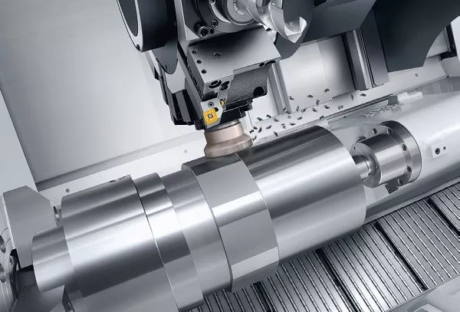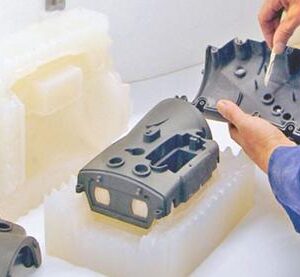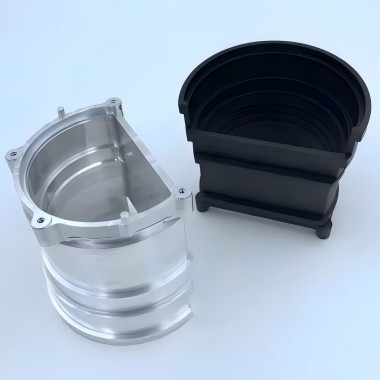
The working principle of CNC milling is mainly based on computer numerical control (CNC) technology, which controls the movement of the machine tool through a pre-written program to achieve accurate milling of the workpiece. The following is a detailed introduction to the working principle of CNC milling:
Core composition and function
CNC unit: This is the core of CNC machine tools, by the input of information, processing and output of three parts. The CNC unit receives the digital information, interprets, interpolates and logically processes it through the control software and logic circuit of the CNC device, and outputs all kinds of instruction information to the servo system.
Input/output device: The input device is used to transmit various processing information to external devices of the computer. Modern CNC machine tools usually use keyboard, disk and other portable hardware or DNC network communication serial communication to input information. The output device is used to output the internal working parameters of the machine tool to help judge whether the machine tool is working normally.
Servo drive system: By the driver, drive motor, and the machine tool with the executive parts and mechanical transmission components to form the CNC machine feed system. Its function is to convert the pulse signal from the CNC device into the movement of the moving parts of the machine tool.
Measurement feedback devices: including gratings, rotary encoders, laser rangefinders, magnetic grids, etc., are used to measure the actual displacement of the machine table and feed it back to the CNC device to control the machine moving in the direction of eliminating errors.
Work flow
Write machining program: according to the geometric information and process information of the parts drawing, use the specified code and format to write machining program.
Program input: Input the written machining program into the numerical control device.
Information processing and distribution: the numerical control device interprets and interpolates the input program, and distributes the processed instruction information to each coordinate axis.
Actuator motion: The servo drive system receives the command information from the CNC device, and drives the actuator parts (such as tools, worktables, etc.) to move according to the predetermined path and speed.
Workpiece processing: In the process of relative movement of the tool and the workpiece, the excess material on the workpiece is cut off by the rotation and movement of the tool to form the desired shape and size.
Measurement and feedback: The measurement feedback device measures the actual displacement of the machine table in real time and feeds it back to the CNC device to adjust the motion state of the machine tool and ensure the machining accuracy.

Key technology
Interpolation technology: In CNC milling, interpolation technology is used to calculate the moving trajectory of the tool in each tiny period of time according to the starting point, end point and speed requirements of the part profile.
Tool compensation technology: In order to compensate for the impact of tool wear, installation errors and other factors on the machining accuracy, CNC milling is usually used tool compensation technology.
High-speed processing technology: With the development of the manufacturing industry, the requirements for processing efficiency and precision are getting higher and higher. High speed machining technology realizes high efficiency and high precision machining by improving the spindle speed and feed speed of the machine tool.
Application and development
CNC milling is widely used in aviation, automotive, electronics, medical equipment and other fields, especially in the processing of complex shape parts has significant advantages. With the continuous development of the manufacturing industry, CNC milling technology is also constantly improving and innovating, such as five-axis linkage processing technology, intelligent manufacturing technology, etc. These new technologies will further promote the development and application of CNC milling technology.
In short, the working principle of CNC milling is based on computer numerical control technology, and the movement of the machine tool is controlled by a pre-written program to achieve accurate milling of the workpiece. The workflow includes program writing, input, information processing and distribution, actuator motion, workpiece processing, measurement and feedback, etc. With the development of the manufacturing industry, CNC milling technology is also constantly improving and innovating.

What are the application scenarios of CNC milling processing
CNC milling has been widely used in many fields because of its high precision, high efficiency and flexibility. Here are some of the main application scenarios:
1. Mechanical manufacturing
Metal parts and mold processing: CNC milling machine can be used to process various metal parts and molds, such as aluminum alloy, copper, iron and so on. Through programming control, automatic production can be realized and production efficiency can be improved.
2. Automobile manufacturing
Engine parts and body structure parts: In the automotive manufacturing process, CNC milling machines are used to process engine parts, body structure parts and other important parts. By using a high-precision CNC milling machine, the stability and safety of the vehicle can be guaranteed.
3. Aerospace
Precision metal components and turbine blades: Many precision metal components are required in spacecraft, and these components need to be machined with high precision by CNC milling machines. In addition, the turbine blades in the aeroengine also need to be finely polished by a CNC milling machine.
4. Medical devices
Artificial joints and orthodontics: CNC milling machine technology is also widely used in the manufacturing of instruments in the medical field. Through precise cutting technology, the success rate of surgery and the comfort of patients can be improved.
5. Energy industry
Wind power, oil drilling equipment and solar equipment: five-axis milling machines can be used to make these equipment to meet the high efficiency manufacturing needs of the energy industry and improve the quality and durability of energy equipment.

6. Shipbuilding
Complex parts and surface machining: CNC milling technology is used in Marine manufacturing to process a variety of complex parts and surfaces, improving the manufacturing accuracy and efficiency of ships.
7. Electronics
Precision parts processing: In the field of electronic manufacturing, CNC milling technology is used to process high-precision electronic product parts, such as circuit boards, connectors, etc.
8. Mold manufacturing
Complex surface and special-shaped hole processing: CNC milling machine is widely used in the field of mold manufacturing, which can realize the rapid processing of complex surface of the mold, reduce processing time, and improve the accuracy and durability of the mold.
9. Custom parts processing
Small batch, diversified production: CNC milling technology is suitable for small batch, diversified custom parts processing, to meet the different needs of customers.
10. Education and training
Numerical control technology training: In vocational education and training institutions, numerical control milling technology is used to train students’ numerical control programming and machine tool operation capabilities to transport highly skilled personnel for the manufacturing industry.
11. Research and development
New materials and new process research: In the field of scientific research and development, CNC milling technology is used to study the processing properties and application effects of new materials and new processes.

Notes for CNC milling:
CNC milling is a high-precision and high-efficiency machining method, in order to ensure the safety, quality and efficiency of the processing process, the following are the matters that need attention when CNC milling processing:
First, safe operation
Personal Protection:
When entering the workshop, you must wear the work clothes, the cuffs should be tightened, and the shirt should be tied into the pants. Girls should wear a hard hat and incorporate braids into the hat. Sandals, slippers, high heels, vests, skirts and scarves are not allowed to enter the workshop.
You must wear a helmet and goggles to prevent iron filings from splashing your eyes. Install a baffle around the machine to isolate it from the operating area.
Do not wear gloves to operate the machine to avoid being twisted by the machine.
Machine environment:
Be careful not to place obstacles around the machine, and the working space should be large enough to avoid unnecessary machine and equipment collision damage.
Do not touch the knife tip and iron filings with your hands. Iron filings must be cleaned with an iron hook or brush.
Multiplayer collaboration:
If a certain work needs two or more people to complete together, attention should be paid to the coordination between each other to make the machine tool processing more stable.
Second, processing preparation
Machine tool inspection:
Before operation, we must be familiar with the general performance, structure, transmission principle and control program of the CNC milling machine, and master the functions and operating procedures of the operation buttons and indicators.
Before starting the machine tool, check whether the electrical control system of the machine tool is normal, whether the lubrication system is smooth, whether the oil is good, and add enough lubricating oil according to the regulations. Check whether each operation handle is correctly reset, whether the workpiece, fixture and tool have been firmly clamped, and whether the coolant is sufficient.
Drive idle for 3 ~ 5 minutes to check whether the transmission components are normal. After confirming the operation of the machine tool without fault, the machine tool can be started normally to use the machining workpiece.
Tool selection:
Establish the correct milling tool selection, in the processing of a variety of different materials, should choose the right tool to ensure the milling effect.
After the tool is installed, a second test cutting should be carried out to ensure that the tool is firmly installed and the cutting parameters are set reasonably.
Workpiece clamping:
Before clamping the workpiece, the clamping method should be developed. When installing the blank, the table should be padded to avoid damage to the table.
When the workbench is moving, check that the fastening screws should be opened, and the fastening screws should be tightened when the workbench is not moving.
Third, the processing process
Program control:
After the debugging of the program is completed, it must be approved by the instructor to follow the steps, and it is not allowed to skip steps.
Before machining parts, it is necessary to strictly check whether the origin of the machine tool and the tool data are normal and carry out simulation operation without cutting trajectory.
Processing monitoring:
When processing parts, the protective door must be closed, and the head and hand are not allowed to stretch into the protective door, and the protective door is not allowed to be opened during the processing.
During the processing process, the operator shall not leave the machine tool without authorization, and should maintain a high degree of concentration and observe the operating state of the machine tool. In case of abnormal phenomenon or accident, the program should be terminated immediately, cut off the power supply and report in time.
Do not slap the control panel or touch the display. Do not knock the table, dividing head, fixture and guide rail.
It is strictly forbidden to open the control cabinet of the CNC system for viewing and touching. The operator shall not arbitrarily change the internal parameters of the machine tool.
Cutting parameters:
When the cutting depth is certain, the use of a small tip radius can undoubtedly reduce the cutting force. Especially the radial cutting force, and the radial cutting force is the main factor that causes the vibration of slender rod tools or workpieces.
Do not touch the cutting edge and machining parts with your hands when cutting.
The feed must be stopped before the spindle is stopped. If the cutting depth is large, the tool should be stopped first.
Fourth, the end of processing
Clean-up work:
After the workpiece is processed, it is not allowed to use compressed air to clean the machine tool, electric cabinet and NC unit.
Remove chips, wipe the machine, and keep the machine clean with the environment.
Check the status of lubricating oil and coolant, and add or replace it in time.
Machine maintenance:
Turn off the power supply and the main power supply on the operating panel of the machine in turn.
If the machine is not used for a few days, the NC and CRT parts should be powered on for 2-3 hours every other day.
Clean the site and fill in the equipment usage record.
To sum up, CNC milling processing involves multiple aspects of attention, from safe operation to processing preparation, processing process to cleaning and maintenance after processing, each step needs to strictly comply with the relevant regulations and operating processes to ensure the safety, quality and efficiency of the processing process.







